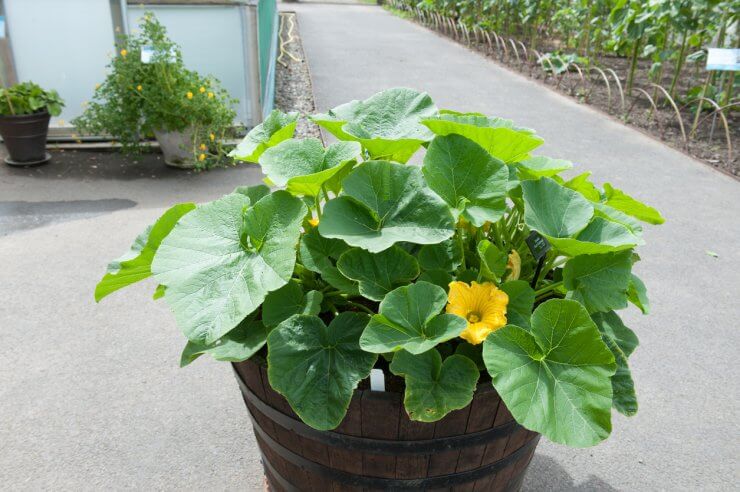
Bush Buttercup winter squash variety growing in wooden barrel
The best winter squash candidates for container gardening are bush squash or semi-bush squash. They don’t produce side vines, so they don’t spread out, or they don’t spread out much—maybe 3 feet in each direction. A large container could handle that.
The key difference between bush squash and vine squash is that bush squash tend to set their fruit at the same time. This can make them vulnerable to insect damage, so you need to keep a close eye on the growing fruits—especially for vine borers and squash bugs.
Compact-growing squash you can consider include:
- Burpee’s Butterbush
- Emerald Bush Buttercup
- Gold Nugget
- Ponca
- Sweet Dumpling
- Table King
You can also grow vining squash in containers; just be sure to provide support for the growing vines. A trellis or strong fence is helpful to keep the vines from overwhelming a small garden space.
Make sure your soil is clean, weed-free, and nutrient-rich. Don’t reuse last season’s soil. It’s always better to start with fresh gardening soil—there’s even soil formulated especially for container gardening. And make sure your containers have good drainage; soggy soil can lead to root rot, which can spell disaster for your squash plants.
The right light for winter squash
Winter squash need at least six hours of sunlight each day to flourish. Putting your container on wheels is one way to help your winter squash get the sunlight they need. Just move them when you need to.
Watering your winter squash plants
Water, sunlight, and soil are all essential ingredients for a successful squash harvest. Watering is one of the easiest things to do—and therefore one of the easiest things to overdo. Your winter squash needs about an inch of water a week. You can supplement whatever nature does not provide. Wherever they’re planted, winter squash need soil with good drainage—and that includes containers! You can mulch the soil around your winter squash to help retain some moisture; also make sure your container has adequate drainage. Just don’t kill your crop with kindness—water just enough, but no more. Too much water can invite disease, and you want to keep your winter squash healthy—leaves, roots, and all!
The right soil for your winter squash plants
For winter squash in containers or planters, use a commercial soil mix that’s formulated for vegetables. This gives your plants a healthy head start, and you’re less likely to introduce weeds or soil-borne diseases by digging up soil from your garden.
Use fertilizer sparingly. If you already have soil that’s rich in organic matter, you don’t need to fertilize. If your soil could use a bit of a boost, choose a vegetable fertilizer to use about two weeks after your winter squash emerge. Follow the directions carefully.
Have you grown winter squash in containers? Please tell us about your successes and challenges growing winter squash in containers.


 Previous
Previous

